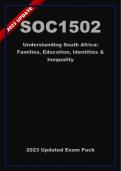Exam (elaborations)
ATRIAL FIBRILLATION/ HEARTFAILURE CASEGUIDE LATEST REVISION GUIDE NextGen UNFOLDING Reasoning Atrial Fibrillation/Heart Failure (2/4)
- Course
- Institution
ATRIAL FIBRILLATION/ HEARTFAILURE CASEGUIDE LATEST REVISION GUIDE NextGen UNFOLDING Reasoning Atrial Fibrillation/Heart Failure (2/4)ATRIAL FIBRILLATION/ HEARTFAILURE CASEGUIDE LATEST REVISION GUIDE NextGen UNFOLDING Reasoning Atrial Fibrillation/Heart Failure (2/4)ATRIAL FIBRILLATION/ HEARTFAILU...
[Show more]












